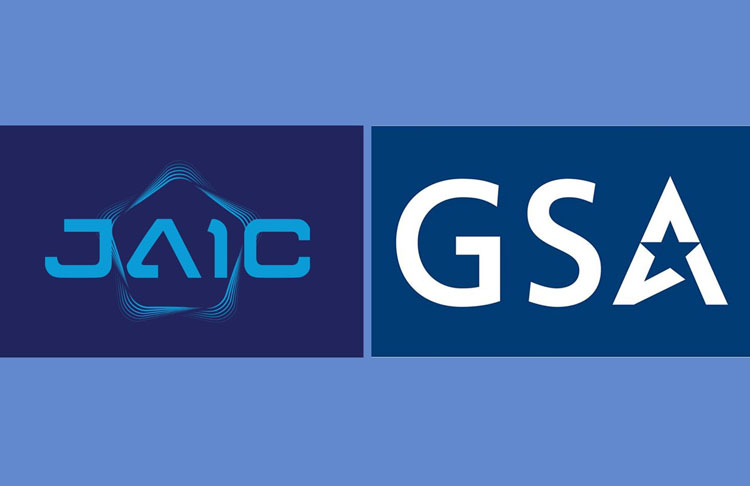GSA Centers of Excellence to Support Development, Rollout of the JCF
- By: The JAIC

The JAIC and the General Services Administration’s Centers of Excellence (CoE) announced in September 2019 that they are partnering on a nine-month-long “discovery sprint” that will help accelerate and expand the adoption of artificial intelligence—not only within the DoD but also across the federal government.
Now that the effort is ramping up, JCF stakeholders, including Mission Initiatives (MIs), can expect to be contacted by a member of the CoE team to set up a one-on-one engagement.
What value will the CoE initiative bring to the JCF team? Essentially, a surge of knowledge and expertise to help speed the development and deployment of the JCF and increase the JAIC’s confidence that the technical specifications of the JCF will support MI goals, objectives, and desired outcomes.
The CoE team is considered the “Tiger Team” of IT modernization within the government. The team members coming into the JAIC are all senior-level innovators and they bring with them subject matter expertise and deep experience in cloud infrastructure, program management, cybersecurity, data and analytics, AI and machine learning, agile methodology, contracting, acquisition, and customer experience, as well as other specialties. Many of those team members also have experience and backgrounds in national security, defense, and intelligence.
“This is a government-to-government effort, a partnership,” explains Matthew Rose, GSA site lead for the JAIC CoE engagement. “Our role is to help accelerate IT modernization in the government. The JAIC is already leading the way on AI in DoD. So we’re aiming to learn everything we can from each other about the strategy and infrastructure needed for AI development and from the lessons learned by different teams. We see integrating ourselves into the culture and structure as a top priority.” Specifically, the CoE will provide deliverables to the JAIC along two critical lines:
- JCF Strategy—The CoE will support the JCF in various ways, including, but not limited to:
- Performing a technical analysis of the JCF design to identify gaps and help translate technical specifications into validated requirements and program elements.
- Reviewing and validating JCF acquisition strategies and artifacts to identify gaps and validate approaches and strategies.
- Providing a summary of findings and recommendations for how to better achieve the JCF Strategy, including the establishment of an AI development platform.
- Acquisition Modernization—The CoE team will help the JAIC develop an improved intake process and procurement management process and provide recommendations for implementing a CoE-developed Acquisition Modernization Plan—all of which will help ensure that the JCF team can obtain the right technologies and manage vendor partners more effectively and efficiently in support of current and future MIs.
“We’re coming in to act as an extension for the JCF,” says Calvert Smith, GSA Lead for the JCF Strategy effort.
“We’re bringing our own set of expertise and knowledge to enhance where the JCF is going, to give it a different set of eyes from a technical standpoint, and to bring in some customer experience experts to help get better information on your users and from the stakeholders within the JCF. We’re going to make sure that what’s being built is exactly what is needed.”
Smith notes that, initially, what he’ll need most from the JCF team is face time.
“We’ll be reaching out to the different stakeholders in the different areas to start setting up meetings so we can get an understanding of their goals, their challenges, and execute deep dives within the JCF to understand what their current ideas are around infrastructure and design,” he explains. “We’ll also be reaching out to the mission areas to define their needs and their levels of satisfaction with the current design of the JCF.”
The CoE is also hoping that its work with the JAIC will result in AI communities of practice, AI playbooks, and AI best practices that other agencies outside of DoD and GSA will eventually be able to leverage to accelerate their own AI efforts, according to Rose.
Info Box: What is the CoE?
GSA’s Centers of Excellence (CoE) was launched in 2017 as a signature initiative of the White House’s Office of American Innovation. The teams bring an objective, highly specialized perspective and seasoned experience to new and longstanding problems.
Team members—a blend of senior federal innovators, Presidential Innovation Fellows, and those with rich private sector experience—work within GSA’s Technology Transformation Services group to help agencies rapidly solve their IT modernization challenges, reduce legacy IT spending, and centralize best practices. The value that CoE teams have already provided to agencies includes the following:
- Designed a cloud and artificial intelligence/machine learning (AI/ML)-enabled Intelligent Data Extraction solution for the U.S. Department of Housing and Urban Development (HUD) to extract structured data from paper case binders, comprised of over 120 million pages annually, and developed multiple advanced analytics use cases using AI and ML to improve HUD mission delivery.
- Worked with the U.S. Department of Agriculture (USDA) to shave months out of the farm loan and Farm Service application processes and established DevSecOps best practices, reference architecture, and requirements for pipelines that can be shared with USDA agencies.
- Developed OneUSDA and HUDCentral Future State Roadmaps that outline the tasks required to achieve the desired future-state visions.
- Brought in by the Office of Personnel Management (OPM) to help stabilize and secure its legacy infrastructure in the wake of a devastating hacking incident.
For more information about the GSA CoE, please visit https://coe.gsa.gov.